I kind of wanted to make curry, and I kind of wanted to make chili. I had excellent coconut milk from the Asian market - the boxed kind, and yes the canned kind is fine, but also yes, the boxed kind is better - and neither chili con carne seasoning nor enough curry powder for a full batch of curry. It's the time of year when my spices all run out at once except for like, cake spice and savory.
So this is basically chili, in that it's made with ground beef and beans and peppers and it's spicy, and kind of curry in that it has coconut milk, but the seasoning blend is actually more of a North African flavor profile, because that's what I had in the house. It really works, though. We had it with rice, usually with chopped scallions on top. I'd avoid the other usual chili accompaniments, though cilantro might work. Naan or pita might work instead of rice, too.
1 1/2 pounds ground beef, browned, fat drained. Even if you don't usually drain the fat for chili, I would do so here because of the coconut milk.
3 red bell peppers and a handful of fresh chiles of your choice (or sub in dried chiles later), diced
3 medium onions, diced
2 tablespoons coconut fat or reserved fat from the ground beef
1 can of beans of your choice, or equivalent of dried and cooked (I used vallarta beans)
500 ml coconut milk
Spices, in order, to taste: generous amounts of cumin, black pepper, coriander; notably smaller amounts of cinnamon, cardamom, paprika, clove
Salt to taste.
Real real simple: brown and drain the ground beef. Saute the onion and pepper in the coconut fat until soft. Add the ground beef back, along with the beans, coconut milk, spices, and salt. Simmer covered for half an hour to meld everything, and uncovered until the coconut milk cooks down and the chili is thick.
Adjust salt and heat level to taste - the coconut milk will take a lot of spice, so feel free to add a few squirts of sriracha.
Okay, check it out.
A food and cooking blog with a focus on interesting ingredients.
Monday, October 20, 2014
Wednesday, August 20, 2014
these are the groceries in my neighborhood
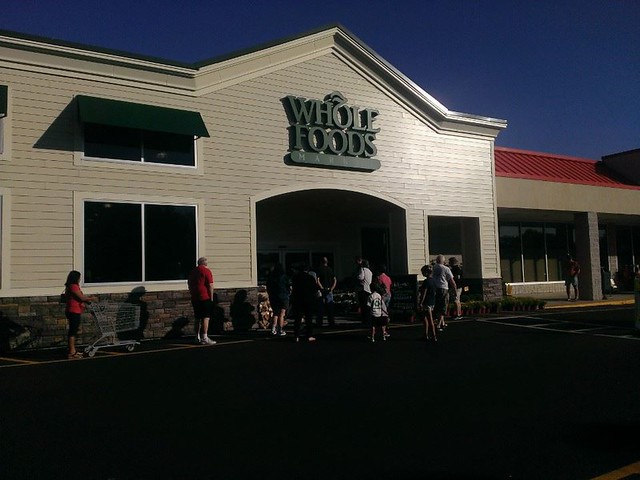
The first Whole Foods in the state is opening right in your town, Bill, I told myself, right in a spot you drive by twice a day bringing Caitlin to the bus station to go to work! As a food blogger, you need to get out there, and you need to cover this.
And I did, and I will. But I want to put it in context first. So this is, simply, an introduction to shopping for food where I live.
The area
I live in Nashua, New Hampshire, a small city despite being the second-largest in northern New England. Nashua's along the southern edge of the state, closer to Boston than it is to the lakes and mountains. There are significant cultural and economic differences between southern and northern New Hampshire, which although relevant here - it's why Nashua got a Whole Foods, not Laconia, and why if Laconia ever does get one, it'll be for the sake of the summer tourists - are beyond the scope of an afternoon blog post. But those differences and the histories behind them touch on every aspect of everything I talk about here. The area is as suburban as it is because* a federal program allowed dairy farmers to cash out at the same time that the last years of the Cold War were fueling the defense and tech industries that set up shop here - Sanders, Lockheed, Raytheon, Wang, Digital, they all employed my friends and neighbors when I was a kid, even while parts of the area (like Hollis, next to Nashua, where I was raised) were still rural enough that traffic stopped to let the cows cross a couple times a day, and we all went uptown to watch the first traffic light do its thing.
(*In part. The process had started before that, and I don't myself know all the factors - New England history is hardly my specialty. But the farm buyout played a major role in continuing and accelerating that process by making land available for developers right at the time that demand for land happened to be high. The student population of the high school in Hollis, for instance, is about 225% as high as it was when I graduated in 1993.)
New Hampshire bobs up and down alongside a couple of other states which like swimmers with a beach ball pass along the title of Whitest State In The Country every couple years. That whiteness is least pronounced in southern New Hampshire, where the Indian population is growing and we are proximate to the large Cambodian population of Lowell, Massachusetts, but when I say "least pronounced," understand that we are comparing ivory and eggshell.
New Hampshire isn't Boston. Boston is culturally distinct from New England as a whole the same way Atlanta's distinct from rural Georgia. But a lot of people in southern New Hampshire certainly depend on Boston, either for work - Caitlin's commute is about an hour and a half, worse in bad traffic - or shopping, and the economy of New Hampshire is heavily dependent on Massachusetts in myriad ways: Massholes shop here because New Hampshire doesn't have sales tax, they move here because it doesn't have income tax and the taxation-to-performance-on-arbitrary-metric-indicating-quality-of-education ratio is historically quite good, they buy cigarettes and liquor here because the state taxes on those are so much lower than Mass's. New Hampshire mocks Massachusetts' taxes, and politicians in NH are derided if their policies seem "more appropriate to Massachusetts," but if Mass taxes WEREN'T so high, New Hampshire would be in a heap of financial trouble.
That too affects the shopping, of course. This Whole Foods, for instance, will draw a lot of northern Massholes up.
No offense about the Masshole thing. It's just the term of art.
So much has changed here since I was a kid, partly due to the prevalence of transplants in southern New Hampshire, and now of the second and third generations of early transplants. The New England palate is pretty timid. You never would have seen sriracha on the shelf when I was a kid, you know? Okay, that was true in most of the country, and that's the thing, I spent my twenties outside of New England, so some of what's changed is just about what's changed in the country as a whole. I don't know if it's because of local or national change that you can get ground buffalo at basically every supermarket here now, for instance, or fish sauce, or persimmons. I just know that I started cooking young enough that you definitely couldn't get that stuff when I lived here the first time round.
So a Whole Foods is a big change, but at the same time, not as big a change as it would have been 25 years ago, or even 10 years ago. The region has been primed for it.
Now if they would just open a Bruegger's here. (All the NH Bruegger's closed before I moved back, and all the NH-based bagel places I've tried have been ... not great, Bob.)
The farmstands
There are a number of farmstands in the area, but I mostly frequent three, all of which are either very close to my condo or up the street from my mother's house in Hollis.
* Lull Farm
I get that it's called Lull Farm, but it's been "Lull's" to me all my life. Lull's is in Hollis, which like I said is the former-farm-town-turned-expensive-housing-development in which I was raised, and where my mother and brother still live. Lull's has gradually expanded in the years that I've been here, including at one point a major renovation that added air conditioning, doubled the cooler space, and added a whoooole lottt of non-farmstand goods. They grow a lot of their own produce, don't get me wrong, but in addition to carrying not-local-and-never-could-be produce like lemons and pomegranates, they've got your Kettle chips, your pretzels, your sodas, your fancy gourmet sauces and mustards (it's where I buy Edmond Fallot mustards), and the most recent addition, a cheese counter.
Lull's always carries things I can't find elsewhere, whether the cheese - though Whole Foods will challenge that - or various apple and potato varieties. They're the only place I know around here to grow callaloo greens.
They're also crowded as shit. This has become more and more true - I suppose the expansion is particularly appealing to people who are driving up from Massachusetts, because the more they can buy, the more worthwhile the drive seems. I used to get around this by going early, an advantage of working at home. Unfortunately, for the last couple years, I have found that if I go in the early morning when I used to, they haven't actually finished putting the produce out, which is especially aggravating at key times of the year when I'm waiting to see if, say, the blueberries or the strawberries are in yet. Quality of service varies a LOT - a lot of the cashiers not only don't know much about what they're selling, but don't keep an eye on the register, which sits unmanned in less busy times.
In addition to their own produce, other local goods include locally made pasta and pasta sauce, locally raised meat, New England cheeses, and local raw milk.
Lull's apple cider is the best around, for my money.
* Brookdale's
Damn near next door to Lull's is Brookdale's, a smaller farmstand serving a farm that does most of its business wholesale. Smaller selection than Lull's, both of local stuff and of the gourmet what's-its and who's-its they offer, but worth checking out periodically.
* Kimball's
Not to be confused with Kimball Farms, an ice cream stand, Kimball Fruit Farm in Pepperell, Massachusetts, is smack on the NH/Mass line across from Hollis, and halfway between my mother's house and my favorite ice cream stand. They also sell produce at various Boston area farmers markets.
Smaller than either Lull's or Brookdale's, Kimball's is in many ways my favorite farmstand. They grow a lot of things other farms don't: sour cherries, fantastic grapes, broccoli raab, and in the past I'm pretty sure we got fava beans there. The heirloom apple selection is terrific, and they sell crabapples, including some that are just sweet enough to eat out of hand.
This is the benefit to living in New England, you know? Being able to get the good apples.
The grocery stores
* Hannaford
The nearest store to me, Hannaford is based in Maine, and is the second-largest supermarket chain in New England. Maybe because of that, it gets a bad rap from a lot of people. This is the only location I'm familiar with, and I've always loved it. The fish and meat are both better at Harvest Market, while Market Basket has more variety of both, but this is where I find most of what I need, usually at a good price.
Hannaford is currently in the middle of an expansion, and the store is total havoc - which is exacerbated by the Market Basket situation.
* Market Basket
Market Basket has been invaluable to me as a source of lesser known cuts of meat -- pig tails, pork belly -- and Latin and Asian produce. For a while they also carried Sun Drop, though for some reason the location nearest me has stopped doing that.
Market Basket's been in the news a lot lately - it's the only thing people talk about as much as the weather. I couldn't begin to summarize everything myself; suffice to stay, I stand with Arthur T., and haven't been shopping there. It's been impressive seeing such a large labor action, and it's been clear how big an impact Market Basket has had on the culture of Massachusetts and New Hampshire. What that Wikipedia article leaves out is how many Market Baskets were historically opened in what we would now call food deserts, offering a win-win situation: working class families could get cheaper groceries than the corner store vultures offered, while Market Basket was able to operate in places their competitors had neglected. The economic toll of the current situation on MB customer families has been significant.
* Harvest Market
There is a small Harvest Market in Hollis. More expensive than the other two stores, with somewhat erratic pricing - I was shocked to find out, post-checkout, that a bottle of Angostura bitters had cost me something like fifteen dollars. Not everything is expensive, or even over-priced - you just have to pay attention to what you're buying. The produce selection is negligible: purely utilitarian, grab a few things so you don't need to go to Nashua. The meat selection is small but the quality is good - best supermarket ground beef of any of these stores, often quite good steaks and lamb chops, and one of the few local carriers of Smart Chicken. (MB carries Bell and Evans' air-chilled chicken, though.)
Harvest has a handful of things I can't find elsewhere - for a while, it was the only place I could find Louisiana hot sauce, for instance, and I've often found goat butter there.
* Wal-Mart
Yes, I have issues with Wal-Mart too. But they are the only store that carries, for instance, canned field peas, frozen black-eyed peas, and lamb belly. Until recently they were the only place I could find Valentina hot sauce, but Hannaford carries it now (along with frozen okra, which I also had to get at WM in the past).
* Lanna Asian Market
Our main local Asian market, Lanna has a lot of Filipino goods, as well as Southeast Asian, Chinese, and Japanese items. No fresh meat or seafood, but the fresh produce includes various greens and herbs, daikon, and green papaya.
Staples from here for me include coconut milk (boxed when I remember to buy it), Indonesian ramen, green papaya, Korean rice cakes, and of course various soy sauces.
* Trader Joe's
As I recently patiently explained to an internet troll, Trader Joe's (Trader Joe's's's's's) business model is weird but nevertheless clear. They don't compete with your regular supermarket. Unless some TJ's are significantly different from the seven or eight locations I've been to, you could never meet all your grocery needs there - there are too many basics they don't carry, and many many more categories where they only carry one or two items, usually their store brand. You're not gonna get Coca-Cola, Kool Aid packets, paper towels, and pickles there. Half of your shopping list is probably not on the shelf.
So how do they get you in? By selling what they sell. Same as with an Asian market, a Russian market, a Latino market. You don't go there to get everything. You go there for what they have.
What they have is determined by their weird but effective method of only stocking the bestsellers. Something stops selling like hotcakes, they stop carrying it. New stuff comes and goes all the time, even beloved things, because they're not beloved enough. This is basically the selling point, because the cult of TJ's revolves around trying all this new shit. That's also why you hear so much about their snack foods - people may go in for cutlets and grapes, but they're gonna get the triple ginger cookies, the cookie butter ice cream, the peanut butter filled pretzels.
Because they only sell bestsellers, prices are relatively low. I'm always surprised by how little I spend there, even when I'm stocking up. Their Salsa Autentica, for instance, is a staple for me, but it's only two dollars a jar. Their frozen croissants are fucking brilliant, especially the almond ones, and the cheese selection usually includes a few fantastic bargains (Five-Year Cheddar was a recent one).
*** Whole Foods!
Okay, there's your context! There's your status quo.
They've been talking about a Whole Foods for most of the eight years since I moved back to New Hampshire. They took ages to pick a location once they finally announced Nashua as an official location, and I've lost track of how long this location was under construction. It's opened in the same location as a former Market Basket, though they rebuilt the whole plaza (and relocated my childhood Papa Gino's in the process).
I just said "location" way too much, but I need to wrap this post up eventually.
Whole Foods isn't Trader Joe's. It will not save you money. If you do your regular shopping there, you're gonna feel it. On the other hand, it doesn't have to cost an arm and a leg, either, and I was surprised how many good deals I saw today - San Pellegrino sodas at $3 for a six-pack, for instance, which is half the price I often see them at, and possibly the least I have ever spent on them since moving here. There were a lot of good deals under the 365 house brand, too - I put another brand of tangerine juice back when I realized a half gallon of 365 tangerine juice was less than twice the price of a single serving of the other brand. Can't speak to relative quality having only bought the one, but even so.
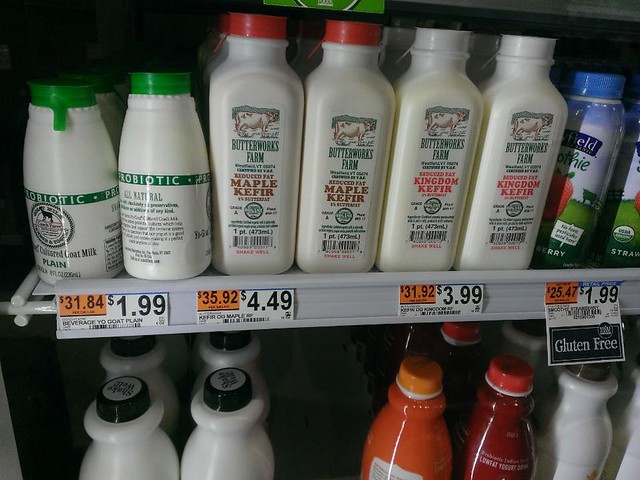
The quality at Whole Foods is high, but there is a definite audience they have in mind. For instance, I noticed probiotic foods are very popular with this presumably health-minded demographic, and there were a lot of probiotic drinks, yogurts, and yogurt drinks ... but either I missed any kimchi, one of the original probiotic foods, or they just didn't carry enough kinds of it for it to be noticeable.
But they have two different brands of the Icelandic yogurt skyr, you know? Two skyrs! Multiple flavors! So this is going to be an interesting adjunct to my shopping, for sure.
I didn't do a big shop, but tried to take some photos to capture some highlights.
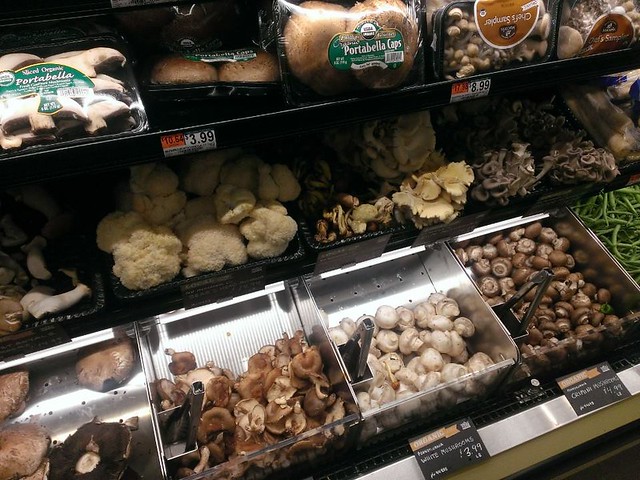
Mushrooms! Many kinds of bulk mushrooms, including several - bear's head, notably - that I have not seen before.
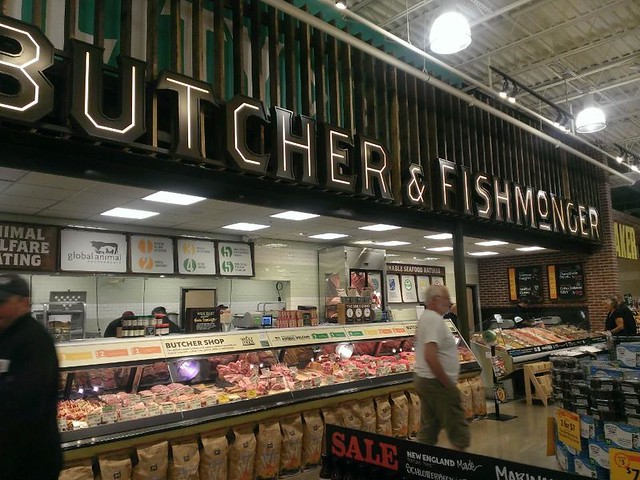
The fish counter didn't really have anything unusual, but the butcher had some nice things, including pork belly and Irish-style bangers.
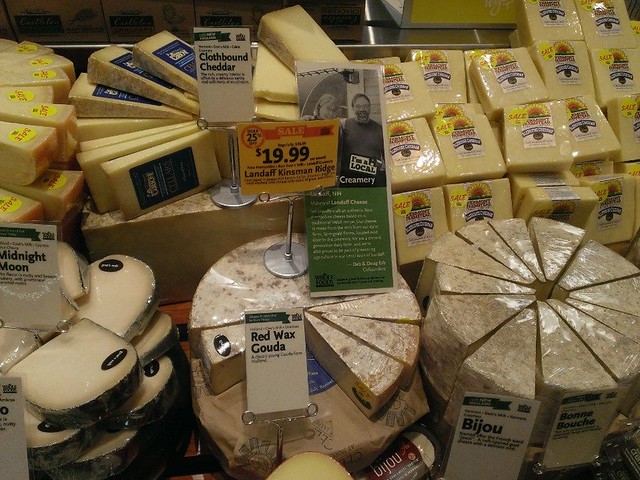
Similarly, not a lot at the cheese counter that I haven't seen before, though a lot of it is stuff I don't find at other New Hampshire supermarkets. Kinsman Ridge, Caitlin's favorite cheese, was the current sale cheese, which is a good sign.
Yesterday was the Grand Opening, and it was PACKED from what I hear - even when I passed by last night around eight, the parking lot was dense with cars. This morning was not bad at all. I imagine this weekend - when everyone who hasn't been able to go to Market Basket suddenly has another option, albeit a much less affordable one - will be a madhouse.
Saturday, August 9, 2014
farmstands 8-9-14
A farmstand report with a little more meat!
I stopped at Lulls ostensibly for cheese and wild blueberries, but the local melon is in, corn is going strong, heirloom tomatoes are getting going, peaches and nectarines were strong. There was a lot of non-local produce too - strawberries, Thomcord grapes (a first - I've only seen them at Trader Joes before), New York state sour cherries, champagne grapes.
David, the owner and operator, was there and making conversation, so I asked him why they don't grow black raspberries anymore. At Kimballs they don't grow black raspberries because demand is insufficient. David had a different answer for Lulls: pests.
According to Dave, there's a new fruit fly in the United States that first arrived in New England 3-4 years ago and is especially aggressive, and it's changed pest management for berries. Since raspberries are soft, pest management is the hardest for them - "they go bad so quickly anyway that there was always a lot of loss of product" (we had just been talking about loss of product in a lengthy conversation about melon farming, because of the difficulty of knowing when they're perfectly ripe, especially when you grow ten different varieties). "So many of the New England grown raspberries you buy are riddled with maggots from the fruit flies," David said. "You have to spray all the time to keep them away. We just don't grow them anymore. I planted flowers where the raspberries used to be." The raspberries sold at Lulls come from Driscoll instead, in Mass.
So that explains not only why I haven't seen black raspberries in a few years, but golden raspberries either, and I just hadn't noticed that the red raspberries at Lulls weren't even their own.
I stopped at Lulls ostensibly for cheese and wild blueberries, but the local melon is in, corn is going strong, heirloom tomatoes are getting going, peaches and nectarines were strong. There was a lot of non-local produce too - strawberries, Thomcord grapes (a first - I've only seen them at Trader Joes before), New York state sour cherries, champagne grapes.
David, the owner and operator, was there and making conversation, so I asked him why they don't grow black raspberries anymore. At Kimballs they don't grow black raspberries because demand is insufficient. David had a different answer for Lulls: pests.
According to Dave, there's a new fruit fly in the United States that first arrived in New England 3-4 years ago and is especially aggressive, and it's changed pest management for berries. Since raspberries are soft, pest management is the hardest for them - "they go bad so quickly anyway that there was always a lot of loss of product" (we had just been talking about loss of product in a lengthy conversation about melon farming, because of the difficulty of knowing when they're perfectly ripe, especially when you grow ten different varieties). "So many of the New England grown raspberries you buy are riddled with maggots from the fruit flies," David said. "You have to spray all the time to keep them away. We just don't grow them anymore. I planted flowers where the raspberries used to be." The raspberries sold at Lulls come from Driscoll instead, in Mass.
So that explains not only why I haven't seen black raspberries in a few years, but golden raspberries either, and I just hadn't noticed that the red raspberries at Lulls weren't even their own.
Monday, August 4, 2014
farmstand 8-2-14
Here at last: Plums! (For the last week.) Sour cherries! Tomatoes! Wild blackberries!
Still to come: Grapes, wild blueberries, early apples like Gravensteins and Jersey Macs.
Caitlin brought some chicken of the woods and black trumpet mushrooms home from the Copley Farmers Market. Chicken of the woods is a large orangish-brownish-yellowish mushroom that, like hen of the woods or maitake, can taste a lot like chicken when it's cooked - and as we discovered, it's a lot more chickeny than hen of the woods, losing very little volume when sauteed and having a firm meaty texture.
Last night we had tacos of a sort -
Potato flatbread for the tortillas: mashed potatoes mixed with flour, salt, and a dash of baking powder until it was the texture of a dough that could be rolled out (I'm not providing proportions because it just depends on how wet your potatoes are), cooked for 90-120 seconds per side.
Filling: chicken of the woods and black trumpet mushrooms sauteed with smoked olive oil, cumin, chard, and scallions, and salt. (Particularly with the chard, you don't want to skimp on the salt.)
Salsa: finely diced carbon tomato, cucumber, scallion, serrano pepper, lemon juice, salt.
Of course, this fairly healthy meal was partly to off-set the chicken-fried meatloaf of a few nights ago:
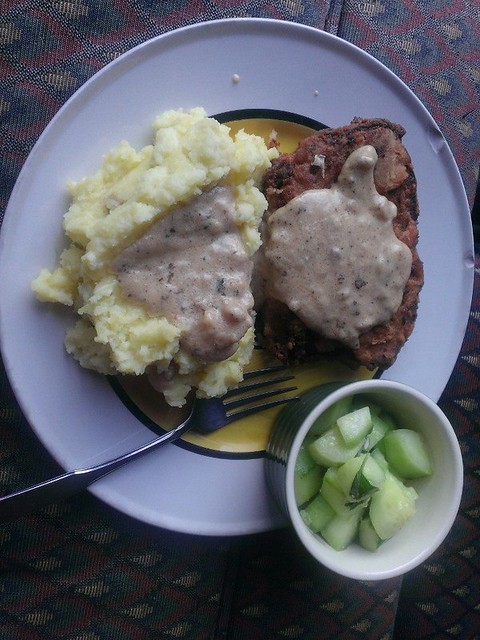
Chicken-fried meatloaf is exactly what it sounds like: I made a meatloaf (making sure not to skimp on the filler, because it should be firm), chilled it, sliced it, dipped the slices in seasoned flour, then egg and milk, then seasoned flour again, and pan-fried them until crispy. The gravy is made from the drippings of the meatloaf, flour, and milk.
Still to come: Grapes, wild blueberries, early apples like Gravensteins and Jersey Macs.
Caitlin brought some chicken of the woods and black trumpet mushrooms home from the Copley Farmers Market. Chicken of the woods is a large orangish-brownish-yellowish mushroom that, like hen of the woods or maitake, can taste a lot like chicken when it's cooked - and as we discovered, it's a lot more chickeny than hen of the woods, losing very little volume when sauteed and having a firm meaty texture.
Last night we had tacos of a sort -
Potato flatbread for the tortillas: mashed potatoes mixed with flour, salt, and a dash of baking powder until it was the texture of a dough that could be rolled out (I'm not providing proportions because it just depends on how wet your potatoes are), cooked for 90-120 seconds per side.
Filling: chicken of the woods and black trumpet mushrooms sauteed with smoked olive oil, cumin, chard, and scallions, and salt. (Particularly with the chard, you don't want to skimp on the salt.)
Salsa: finely diced carbon tomato, cucumber, scallion, serrano pepper, lemon juice, salt.
Of course, this fairly healthy meal was partly to off-set the chicken-fried meatloaf of a few nights ago:

Chicken-fried meatloaf is exactly what it sounds like: I made a meatloaf (making sure not to skimp on the filler, because it should be firm), chilled it, sliced it, dipped the slices in seasoned flour, then egg and milk, then seasoned flour again, and pan-fried them until crispy. The gravy is made from the drippings of the meatloaf, flour, and milk.
Wednesday, July 23, 2014
farmstands 7-23
The first of the local corn and peaches are in!
Still available: raspberries, domesticated blueberries, squash and brassicas, potatoes, onions, carrots, radishes.
Not yet: non-hothouse tomatoes, sour cherries, blackberries (not sure who's selling them these days), non-red raspberries (likewise), other berries, grapes, apricots, plums.
Gone: strawberries, sweet cherries, lettuce (not sure I ever saw it this year). Green garlic looks like it's all dry now, garlic scapes seem to be gone.
Some kind of cooking post soon.
Still available: raspberries, domesticated blueberries, squash and brassicas, potatoes, onions, carrots, radishes.
Not yet: non-hothouse tomatoes, sour cherries, blackberries (not sure who's selling them these days), non-red raspberries (likewise), other berries, grapes, apricots, plums.
Gone: strawberries, sweet cherries, lettuce (not sure I ever saw it this year). Green garlic looks like it's all dry now, garlic scapes seem to be gone.
Some kind of cooking post soon.
Monday, July 7, 2014
papaya salad
Papaya salad might be my favorite dish in the world.
Maybe I'm hedging by saying "dish," so that sour cherries, fresh tomatoes, or whiskey can still be my favorite food, I don't know. But I'm telling you, papaya salad is way up there.
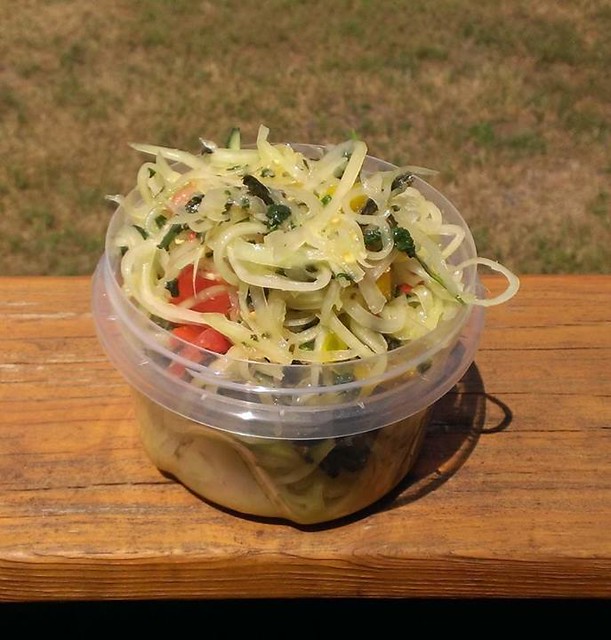
If you haven't had it, both "papaya" and "salad" are a little misleading. It's almost like a coleslaw, and feel free to use it as one. The papaya used for it is green - unripe - and shredded before being pounded in a mortar and pestle with lime juice, fish sauce or other source of salt (plain salt or soy sauce is fine to keep it vegan), fresh herbs and seasonings, and often some other vegetables - blanched long beans are common, as are tomatoes and raw Thai eggplant. I tend to use just papaya and tomato for the vegetables - I want the papaya to provide all the texture.
Papaya salad comes from Southeast Asia - it's often on Thai restaurant menus, and is called som tam in Thailand - and is perfect hot-weather food, but like I said, don't feel you have to limit it to other Southeast Asian contexts. Have it on a hot dog. Have it with some boiled crawfish or shrimp. Have it with fried chicken or fish.
This is more about technique than recipe. The two key things are, of course, shredding and pounding the papaya. Well, and finding green papaya in the first place. An Asian market is your best bet, though the Market Basket here in suburban New Hampshire carries it now, so who knows. You may be able to find it already shredded - I used to be able to. If you can't, you can use a mandoline or a very sharp knife, but I tell you what, I am in love with the Kom Kom miracle knife:
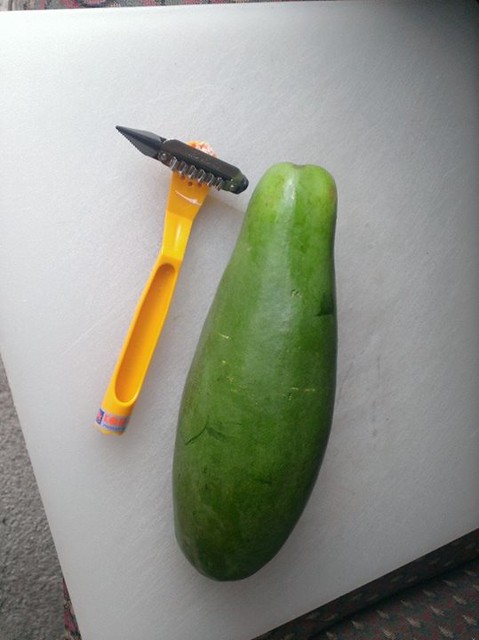
The Kom Kom works like a peeler - you pull it across the fruit (after you've peeled it, unlike the above photo) and instead of cutting away a layer of peel, it cuts thin julienned strips. Check it out:
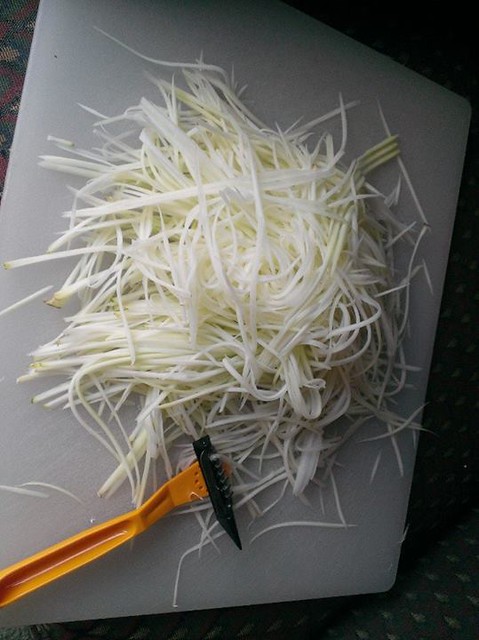
It took me a few years of occasionally trying to make papaya salad to realize that you really HAVE to pound it. You can't just toss the shredded papaya with the seasonings. Pounding it tenderizes the unripe fruit and lets the seasonings seep in. You'd be surprised how hard you can pound it without mashing it.
Ideally you want to pound it in a Lao-style clay mortar, the important aspect of which is that it has a narrow bottom and high sides, which is perfect for this. I know it sounds like I'm saying you need a lot of special equipment. And maybe you do! But a regular mortar and pestle will work too, just not as easily.
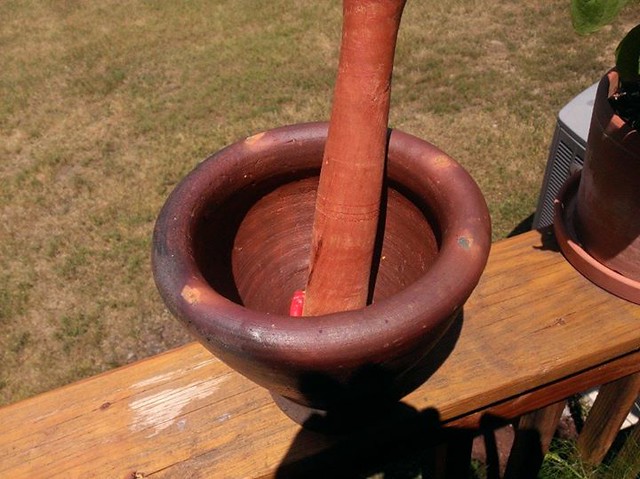
This is less than half of the shredded papaya in the mortar. It'll shrink down a lot once pounded:
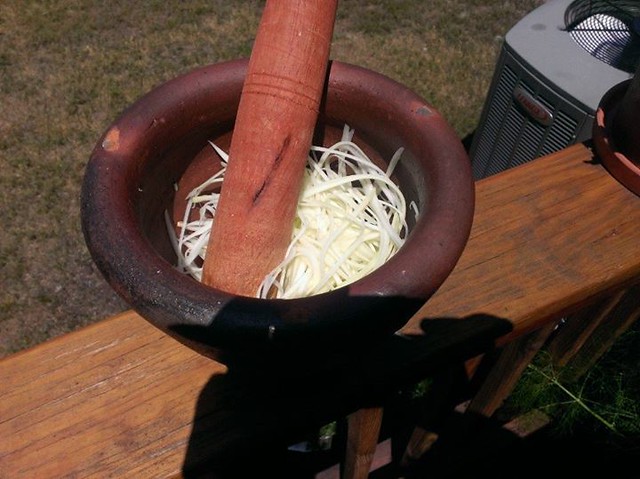
So everything about this is "to taste," but you want:
Fresh lime juice;
Fish sauce or other salt (salt, soy sauce, shrimp paste, crab paste, mud crabs);
Chile (I used a small red Thai chile);
Fresh herbs (mint, cilantro, culantro, and/or any basil - I also used sorrel this time, and was out of mint);
Other seasonings that appeal to you - I use ginger and lemongrass, garlic is common;
A little sugar;
Other vegetables if you like. I add a few cherry tomatoes. Parts of Thailand also add peanuts.
Pound the ingredients together, making sure the herbs are good and bruised, everything but the papaya (and long beans if you're using them) is pulverized, and the papaya is tenderized. There's a technique that this mortar lends itself naturally to of tossing the papaya a little with the pestle and then banging it against the side as it falls. Soon enough:
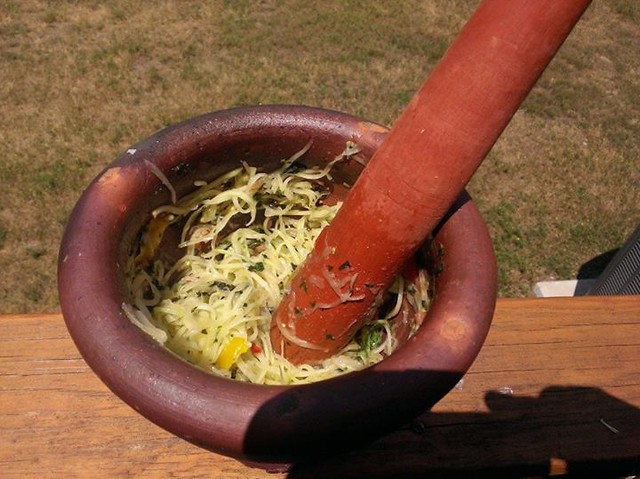
Tada.
You want the flavors balanced - a little tart, a little sweet, very green and herbal, a bit spicy (sometimes very spicy).
Maybe I'm hedging by saying "dish," so that sour cherries, fresh tomatoes, or whiskey can still be my favorite food, I don't know. But I'm telling you, papaya salad is way up there.

If you haven't had it, both "papaya" and "salad" are a little misleading. It's almost like a coleslaw, and feel free to use it as one. The papaya used for it is green - unripe - and shredded before being pounded in a mortar and pestle with lime juice, fish sauce or other source of salt (plain salt or soy sauce is fine to keep it vegan), fresh herbs and seasonings, and often some other vegetables - blanched long beans are common, as are tomatoes and raw Thai eggplant. I tend to use just papaya and tomato for the vegetables - I want the papaya to provide all the texture.
Papaya salad comes from Southeast Asia - it's often on Thai restaurant menus, and is called som tam in Thailand - and is perfect hot-weather food, but like I said, don't feel you have to limit it to other Southeast Asian contexts. Have it on a hot dog. Have it with some boiled crawfish or shrimp. Have it with fried chicken or fish.
This is more about technique than recipe. The two key things are, of course, shredding and pounding the papaya. Well, and finding green papaya in the first place. An Asian market is your best bet, though the Market Basket here in suburban New Hampshire carries it now, so who knows. You may be able to find it already shredded - I used to be able to. If you can't, you can use a mandoline or a very sharp knife, but I tell you what, I am in love with the Kom Kom miracle knife:

The Kom Kom works like a peeler - you pull it across the fruit (after you've peeled it, unlike the above photo) and instead of cutting away a layer of peel, it cuts thin julienned strips. Check it out:

It took me a few years of occasionally trying to make papaya salad to realize that you really HAVE to pound it. You can't just toss the shredded papaya with the seasonings. Pounding it tenderizes the unripe fruit and lets the seasonings seep in. You'd be surprised how hard you can pound it without mashing it.
Ideally you want to pound it in a Lao-style clay mortar, the important aspect of which is that it has a narrow bottom and high sides, which is perfect for this. I know it sounds like I'm saying you need a lot of special equipment. And maybe you do! But a regular mortar and pestle will work too, just not as easily.

This is less than half of the shredded papaya in the mortar. It'll shrink down a lot once pounded:

So everything about this is "to taste," but you want:
Fresh lime juice;
Fish sauce or other salt (salt, soy sauce, shrimp paste, crab paste, mud crabs);
Chile (I used a small red Thai chile);
Fresh herbs (mint, cilantro, culantro, and/or any basil - I also used sorrel this time, and was out of mint);
Other seasonings that appeal to you - I use ginger and lemongrass, garlic is common;
A little sugar;
Other vegetables if you like. I add a few cherry tomatoes. Parts of Thailand also add peanuts.
Pound the ingredients together, making sure the herbs are good and bruised, everything but the papaya (and long beans if you're using them) is pulverized, and the papaya is tenderized. There's a technique that this mortar lends itself naturally to of tossing the papaya a little with the pestle and then banging it against the side as it falls. Soon enough:

Tada.
You want the flavors balanced - a little tart, a little sweet, very green and herbal, a bit spicy (sometimes very spicy).
Wednesday, July 2, 2014
farmstands 7-2
Not much new to report except that local sweet cherries (Bings or close relatives) have been available for a few days and are very good this year. No raspberries or blueberries yet, though I expect them to be early.
Out in the garden, the fennel is getting crazy tall but the bulbs are still thumb-sized. I don't know if this means that, like with celery, fennel grows taller and bushier than you would guess from what you see in the supermarket, or if at some point the plant stops putting energy into growing stalks and starts putting it into developing the bulb.
Out in the garden, the fennel is getting crazy tall but the bulbs are still thumb-sized. I don't know if this means that, like with celery, fennel grows taller and bushier than you would guess from what you see in the supermarket, or if at some point the plant stops putting energy into growing stalks and starts putting it into developing the bulb.
Subscribe to:
Comments (Atom)